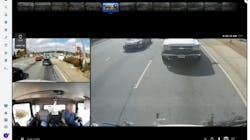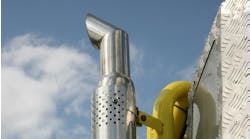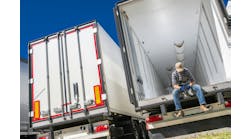In June, I traveled out of state three times to cover three extremely different events. It was an equally exhausting and informative month.
First was Penske Truck Leasing’s National Tech Showdown in Mooresville, North Carolina. The competition is Penske’s diagnostic-heavy version of TMCSuperTech and was held in Team Penske’s Race Shop.
Watching a bunch of dudes swap between standing at a laptop and climbing inside a Freightliner cab for 40 minutes was not as riveting for a spectator as watching Team Penske’s pit crew change an Indy car’s tires and fuel tank in under 10 seconds. Still, the trip to the world-class facility was extremely beneficial.
Aside from the cool factor of touring the various departments, including the secretive Porsche Penske Motorsport wing, the gym where the pit crews train, and inside the specialty trailers, I got a chance to see hard-working diesel technicians being treated like royalty.
Mind you, Team Penske less than two weeks prior had won both the Indy 500 and NASCAR Coca-Cola 600, but at least for a day, the 16 technicians (who beat out more than 1,600 colleagues) were able to take a victory lap.
And they deserve it, as uptime is the main selling point to Penske customers, and that’s what the company’s 10,900 techs provide. Art Vallely, president of Penske Truck Leasing, made that point clear during the awards ceremony.
“You’re the number one group—the group that is responsible for our revenue growth in the company,” Art Vallely said to the finalists.
He also told them they would get even more VIP treatment at the Indy 500 in 2024.
The next week, Fleet Maintenance Associate Editor Cris Beaulieu and I drove from Cleveland before dawn to Romeo, Michigan, home of the Ford Michigan Proving Grounds, to test drive the 2023 F-Series Super Duty.
Rambling along the winding roads towing 30,000 lbs. gave me an appreciation for the drivers who do the job every day. The advanced driver assist system (ADAS) features, such as Blind Spot Information System, meanwhile, gave me an appreciation for the latest technology they cram into these trucks.
Cameras on the trailer provide a split-screen view on the dash infotainment screen to show the trailer was still on the road during wide turns. Among many innovations, Super Duty owners can now take advantage of Pro Trailer Hitch Assist, and it helped this Hitch like a pro. The truck locates the trailer hitch (if it’s within 20 feet), uses artificial intelligence to calculate the correct angle of approach, and autonomously does the hard work for you. It worked perfectly, though I still don’t think autonomous trucks will hit widescale adoption anytime soon.
There will always be the folks who prefer to do things the manual way, but having the machine do certain jobs for you does ensure speed and accuracy. There’s no shame in it. Honestly. It would be like me deriding you for using Grammarly or spell check (both of which even I occasionally use for quabity assurance). And someday I’ll probably have ChatGPT write this column for me.
Putting more technology onboard means more data, and Ford Pro is growing its telematics ecosystem (30% of Ford’s 12 million commercial vehicles in operation have modems) to harness that data. This opens the door to more predictive maintenance, which is a bit like ADAS for the maintenance side.
Just as automatic emergency braking engages even if you don’t see the vehicle ahead, predictive maintenance algorithms will detect when service, like an oil change, is needed due to remaining oil life, or if a serious issue could threaten uptime.
“We’ll know in advance, we can order the parts in advance, and they could be there to effect the repair when you come through,” explained Tim Baughman, Ford Pro general manager. “And this is where we’re heading.”
The next Wednesday, I was headed to Austin, Texas, for Samsara’s Beyond ’23 conference.
One of the first things Samsara CEO Sanjit Biswas talked about was how the acceleration of technology is growing exponentially. It took 15 years to get from zero to 100 million PCs and two years to get from zero to 100 million smartphones, he explained. More recently, ChatGPT was adopted by 100 million people in only two months.
It’s hard to forecast all the ways transformative technology will impact society, but here’s something to ponder. If you wanted to design a website or post a blog 20 years ago, you had to learn HTML. Now it’s all drag-and-drop and anyone can do it. AI will likely head the same way. It’s not a stretch to imagine a shop AI assistant (ChatDTC?) that can access millions of work order histories and instantly diagnose the problem, automatically order parts, schedule repairs, and assign the technician.
After hearing about how Samsara is making third-party data integration easier, and talking with several of the telematics company’s partners, this is on the horizon. Does this spell the end of diagnostic techs and even shop supervisors? Hopefully not.
Biswas envisions AI will serve as a “co-pilot” for fleet managers, sharing the cognitive load, if you will. That is certainly a possibility. It’s more likely than robots taking over the shop anytime soon.
With all my recent travel, I sure wish I had an AI helper to help me catch up and answer emails and proof copy. But at what point do we give up too much and lose purpose? Diagnostic technicians like Missy Albin love the problem-solving aspect of CV maintenance. Would the industry attract great people like her if AI did 90% of the work, or would it attract only people willing to do 10% of the work? I don’t have the answer, but what I have learned from all these visits is that technology should be treated like a tool, not a cure.
AI will make things faster and easier for you, as well as your competitors. What will define your success is still the same as always: your workers and how you can support them.






